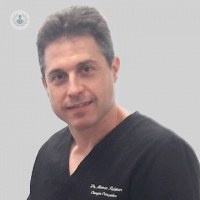Hip prosthesis, an individualized intervention
Written by:The hip prosthesis is an intervention that is performed more and more often, due to the increase in the age of the population and the reasonable demand for quality of life by patients.. This improvement responds to the fact that patients with a certain age still have a very active life that they do not want to be limited by joint pain .
It is an artificial substitute for a hip that the patient has worn, since that wear is causing pain and functional limitation. The most suitable component for each patient will depend on the type of hip and according to the problem he suffers.
Parts of the prosthesis
The parts of a basic hip prosthesis are the stem , the neck of the stem (portion that is anchored in the femur), the head and acetabulum (the cup that is anchored to the pelvis) and the head (of variable composition). The metal parts of the prosthesis are metal alloys, compatible with humans and resistant.

Placement of a prosthesis
There are two essential conditions to perform the intervention for the placement of a hip prosthesis. One must be that the osteoarthritic hip , worn out , supposes pain for the patient and two, that ends in a functional limitation. These conditions are much more important than the degree of osteoarthritis and deformity of the patient.
The idea is to implant the prosthesis in patients who need it for their severe symptoms, individualize each implant that is the best for that patient, and then take care of the prosthesis so that it lasts many years, following the instructions of its surgeon. The first months are more important than it seems for the implant to survive for life.
Implantation of the prosthesis
The patient, once the surgery is done, will remain admitted between 4 and 6 days. This is done under regional anesthesia , waist down, and light sedation, so that the patient does not feel pain or discomfort during surgery. The procedure consists of placing the placement of the pelvic component, the cup, using 2 screws in the bottom of the cup, which ensures greater stability and prevents the component from rotating. The stem is then inserted and the size and position of the femoral neck and head are calculated.
Once subjected to the intervention, the first days are the most painful, and the thigh can become inflamed. The patient must remain on his back during the night, with the legs separated and without crossing them between 1 and 2 months. The recovery process takes place once the patient assumes the prosthesis as his own and begins to forget about it.


